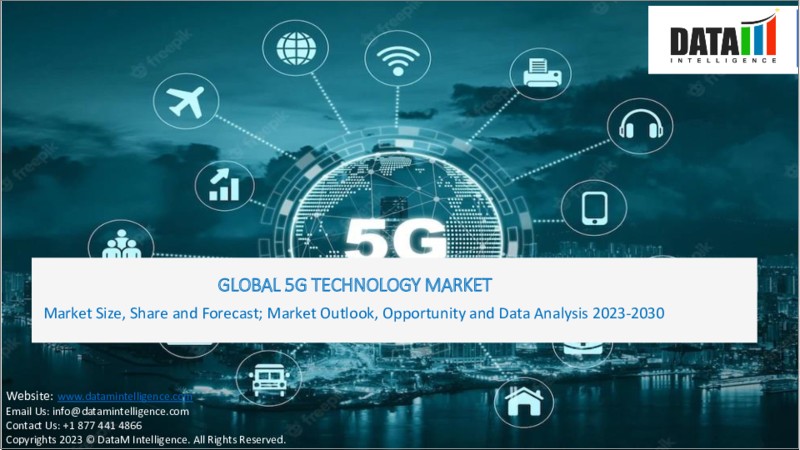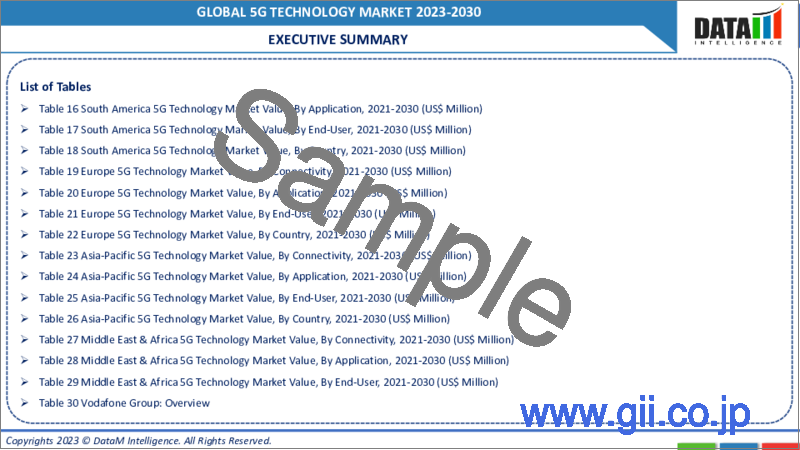|
|
市場調査レポート
商品コード
1297832
5G技術の世界市場- 2023年~2030年Global 5G Technology Market - 2023-2030 |
||||||
カスタマイズ可能
適宜更新あり
|
|||||||
| 5G技術の世界市場- 2023年~2030年 |
|
出版日: 2023年06月15日
発行: DataM Intelligence
ページ情報: 英文 206 Pages
納期: 即日から翌営業日
|
- 全表示
- 概要
- 目次
市場概要
世界の5G技術市場規模は2022年に191億米ドルに達し、2023-2030年の予測期間中にCAGR 44.2%で成長し、2030年には3,571億米ドルに達すると予測されています。
5G技術は、柔軟性の拡大、遅延の減少、無線サービスの高速化を目指しています。クラウドベースの体験を顧客に提供することで、5Gは世界中の接続性を高める。予測期間中、市場拡大の原動力となるのは、より高速で高速なデータ接続に対する需要の高まりと、デジタル化と技術進歩の拡大であると予測されます。
5Gの速度やその他の接続の利点により、企業はより効率的になり、顧客はより多くの情報に迅速にアクセスできるようになります。ヘルスケア投資の増加も、世界の5G技術市場の拡大を後押しすると予測されています。例えば、インド政府は2021年、特別奨励プログラムを通じて遠隔医療とデジタルヘルスに関する75の事業に資金を提供する予定です。
市場力学
エッジコンピューティングとIoTデバイスの利用拡大
エッジコンピューティングは、全体的なパフォーマンスと信頼性を高めながら、迅速な応答時間でリアルタイム分析を可能にします。また、エッジコンピューティングは、プライバシーやセキュリティに関する懸念の緩和にも役立ちます。例えばメルセデスは、リアルタイム認証が可能なセンサーの待ち時間を短縮し帯域幅を改善するために、エッジサーバーと5G無線接続を採用しています。
エッジコンピューティングの必要性とIoTデバイスが生み出すデータ量は、いずれもデータ速度の高速化に対する需要を高めると予想されます。インターナショナル・データ・コーポレーションの2021年のデータによると、リンクされたIoTデバイスの数は400億を超え、2025年には80ゼタバイトを超えるデータが生成されます。5Gコネクティビティは4Gの1000倍の速度で動作すると予想されているため、その利用が市場の成長を後押しすると期待されています。
技術の高コストとサイバー犯罪の増加
新しい基地局、アンテナ、光ファイバー網などのインフラ変更が必要なため、5G技術の導入と展開には多額の資金が必要となります。企業によっては、必要なインフラを構築・維持するための高額な出費が足かせとなる可能性があります。例えば、5Gの無制限料金は、すでに運用されているキャリアの4Gよりも割高です。
スペインの通信サービス・プロバイダーであるCENTUM digitalが示したように、キャリアに基づくデータによると、5Gの平均月額費用は約89米ドルであるのに対し、4Gは68米ドルです。5Gと4Gの無制限プランの平均月額料金の差は5~72米ドルです。従来のアクセス可能な技術と比較すると、新技術は高コストであるため、市場の成長は妨げられると予想されます。
COVID-19影響分析
リモート・コラボレーション・ツール、ビデオ会議、デジタル・ヘルスケア・ソリューションなど、いくつかの業界や使用事例において、COVID-19の流行は5G技術への需要を高めました。製造業や物流などの分野では、eコマースやデジタルサービスへの依存度が高まるだけでなく、遠隔監視や制御への注目も高まっています。この伝染病は、組織や人々に新たな作業方法の採用を促し、5G技術の使用事例を変化させました。
例えば、エリクソンの職場向けモビリティ・レポートでは、ホワイトカラーの60%がビデオ通話の利用を増やしたことが明らかになっています。ネットワークは効果的に機能し、通信事業者は通常、トラフィック・パターンと需要の急速かつ異常な変化にもかかわらず、適切なネットワーク・パフォーマンスを維持しました。
ロシア・ウクライナ戦争の影響分析
5G技術の世界市場は、ロシアとウクライナの紛争の影響を受けています。この紛争により、人々は5Gのインフラとネットワークのセキュリティを心配するかもしれないです。ロシア最大の携帯通信事業者MTSは2020年、5Gの将来に備えて現在の携帯インフラ(2G/3G/4G)の大規模な改修をスウェーデンのベンダーと共同で開始しました。
MTSとエリクソンは2021年4月、サンクトペテルブルクに5Gイノベーション・ハブを建設しました。2021年10月、2社はエリクソンが「5G-Ready」と名付けたプライベートセルラーネットワークの展開を、工業鉄鋼大手セヴェルスタール(PJSC Severstal)などの会社向けに開始しました。現在、ロシアの5Gインフラメーカーは存在しないです。ロシアの5G取引では、中国の大手ベンダーであるファーウェイが主要サプライヤーとなります。
人工知能の影響分析
5G技術の世界市場は、人工知能の恩恵を受けると予想されます。5GとAIの融合により、データソースに近い場所でAI処理を行うことができるエッジコンピューティングが可能になります。自律走行車、スマートシティ、産業オートメーションはすべて、待ち時間の短縮によって可能になります。エッジAIと5Gの融合は、最先端のサービスとアプリケーションケースに新たな展望を生み出します。
エッジ・コンピューティングのコンセプトは、サポートするアプリケーションにより近いサーバーでデータを処理・分析することです。AI処理は5Gのネットワーク設計で容易にサポートされるため、この進化は5Gによって加速されます。AIによってコンピューターやシステムが人間に匹敵する知能レベルで動作するようになる一方で、5Gは他のテクノロジーのスピードと統合を向上させる。
目次
第1章 調査手法と範囲
第2章 定義と概要
第3章 エグゼクティブサマリー
第4章 市場力学
- 影響を与える要因
- 促進要因
- スマートフォンにおける5G技術の需要の高まり
- エッジコンピューティングとIoTデバイスの使用の拡大
- 抑制要因
- テクノロジーのコスト高とサイバー犯罪の増加
- 機会
- 影響分析
- 促進要因
第5章 業界分析
- ポーターのファイブフォース分析
- サプライチェーン分析
- 価格分析
- 規制分析
第6章 COVID-19の分析
第7章 接続性別
- 拡張モバイルブロードバンド(eMBB)
- 超高信頼性低遅延通信(URLLC)
- 大規模マシンアプリケーション通信(mMTC)
- その他
第8章 アプリケーション別
- 商業
- コネクテッドビークル
- VR&AR
- 強化されたビデオサービス
- その他
第9章 エンドユーザー別
- 産業用
- IT&テレコム
- 自動車
- 政府
- その他
第10章 地域別
- 北米
- 米国
- カナダ
- メキシコ
- 欧州
- ドイツ
- 英国
- フランス
- イタリア
- スペイン
- その他欧州
- 南米
- ブラジル
- アルゼンチン
- その他南米
- アジア太平洋
- 中国
- インド
- 日本
- オーストラリア
- その他アジア太平洋地域
- 中東とアフリカ
第11章 競合情勢
- 競合シナリオ
- 市場ポジショニング/シェア分析
- 合併と買収の分析
第12章 企業プロファイル
- AT and T Inc.
- 会社概要
- 製品ポートフォリオと説明
- 主なハイライト
- 財務概要
- BT Group plc.
- China Mobile Ltd.
- China Telecom Corporation Ltd.
- Bharti Airtel Ltd.
- NTT Docomo Kingspan
- KT Corp.
- Saudi Telecom Company
- Vodafone Group
- Deutsche Telekom AG
第13章 付録
Market Overview
The Global 5G Technology Market size reached US$ 19.1 billion in 2022 and is expected to reach US$ 357.1 billion by 2030 growing with a CAGR of 44.2% during the forecast period 2023-2030.
5G technology aims to expand flexibility, decrease latency and speed up wireless service. By providing customers with cloud-based experiences, 5G enhances connectivity across the world. During the forecast period, the market expansion is anticipated to be driven by increasing demands for faster and higher-speed data connectivity, as well as increased digitization and technical advancements.
Businesses will be more efficient owing to 5G speed and other connection advantages, while customers will have faster access to more information. Rising healthcare investments are also projected to boost the global 5G technology market expansion. For instance, in 2021, the Indian government will fund 75 businesses in telemedicine and digital health through a special incentive program.
Market Dynamics
Growing Edge Computing and Use of IoT Devices
Edge computing enables real-time analysis with quicker response times while enhancing overall performance and dependability. Edge computing also helps ease concerns about privacy and security. To reduce latency and improve bandwidth for sensors with real-time authentication, Mercedes, for instance, employs edge servers and 5G wireless connectivity.
The need for edge computing and the amount of data produced by IoT devices are both expected to increase demand for faster data speeds. According to a 2021 data by International Data Corporation, there will be over 40 billion linked IoT devices that produce over 80 zettabytes of data in 2025. Since 5G connectivity is expected to perform 1000 times faster than 4G, its use is anticipated to boost and encourage market growth.
High Cost of the Technology and Growing Cybercrimes
Owing to the requirement for infrastructure changes, such as new base stations, antennas and fiber optic networks, the implementation and deployment of 5G technology includes a large financial commitment. Some businesses may be hindered by the high expenses of creating and maintaining the required infrastructure. For instance, unlimited 5G rates are more expensive than 4G on the carriers that are already in operation.
As given by CENTUM digital, a telecommunication service provider in Spain, according to data based on the carriers, the average monthly cost for 5G is approximately US$ 89, compared to US$ 68 for 4G. The average monthly price difference between the 5G and 4G unlimited plans is between US$ 5 and US$ 72. It is anticipated that the market growth will be hampered by the new technology's high costs when compared to prior accessible technology.
COVID-19 Impact Analysis
In several industries and use cases, such as remote collaboration tools, video conferencing and digital healthcare solutions, the COVID-19 epidemic enhanced the demand for 5G technology. There was a greater focus on remote monitoring and control as well as growing reliance on e-commerce and digital services in sectors like manufacturing and logistics. The epidemic prompted organisations and people to adopt new methods of working, which changed the use cases for 5G technology.
For instance, the Ericsson Mobility Report for the workplace revealed that 60% of white-collar employees increased their use of video calls. The networks worked effectively, with operators typically maintaining adequate network performance, despite the rapid and extraordinary shifts in traffic patterns and demand.
Russia-Ukraine War Impact Analysis
The global market for 5G Technology is impacted by the conflict between Russia and Ukraine. The dispute might cause people to worry about the infrastructure and network security of 5G. The largest mobile operator in Russia, MTS, began collaborating with the Swedish vendor in 2020 on a massive renovation of its current cellular infrastructure (2G/3G/4G) in preparation for a 5G future.
MTS and Ericsson built a 5G Innovation Hub in St. Petersburg in April 2021. In October 2021, the duo began deploying private cellular networks that Erisson dubbed "5G-Ready" for companies such industrial steel giant PJSC Severstal. Currently, there are no Russian manufacturers of 5G infrastructure. For any Russian 5G transactions, it leaves major Chinese vendor Huawei as the primary supplier.
Artificial Intelligence Impact Analysis
The global market for 5G technology is anticipated to benefit from artificial intelligence. Edge computing, where AI processing may be done closer to the data source, is made possible by the convergence of 5G and AI. Autonomous vehicles, smart cities and industrial automation are all made possible by the reduction of latency. The convergence of edge AI and 5G creates new prospects for cutting-edge services and application cases.
The concept behind edge computing is to process and analyse data on servers that are closer to the applications they support. The evolution is accelerated by 5G since AI processing is easily supported by the 5G network design. While AI will enable computers and systems to operate at levels of intelligence comparable to that of humans, 5G will improve the speed and integration of other technologies.
Segment Analysis
The global 5G technology market is segmented based on connectivity, application, end-user and region.
The Growing Implementation of 5G Technology in Autonomous Vehicle
During the forecast period, it is anticipated that the automotive end-user would expand at the highest CAGR. Vehicle-2-Vehicle, Vehicle-2-Infrastructure, Vehicle-2-Network and Vehicle-2-Pedestrian (V2P) communications will all become feasible with the introduction of 5G. To take advantage of the rising use of 5G networks, the companies in the automobile industry are implementing 5G technology.
For instance, Hyundai Mobis announced to have created a 5G-based connection module for automobiles in 2022 to enhance the functionality of connected car systems like autonomous driving. The module provides large-volume data processing in real-time. It combines memory and communication activities using ultra-high speed, ultra-low latency and hyper-connection technologies, as well as radio frequency circuits and GPS.
Geographical Analysis
The Early Adoption of 5G Technology in Automotive Industry in Asia-Pacific
Asia-Pacific 5G technology market is estimated to grow at the fastest rate during the forecast period due to early adoption of the technology in nations like China, notably in the region's automobile industry. By the end of July 2022, China had the largest 5G network in the world, with 1.97 million base stations and 475 million users, according to statistics from the Ministry of Industry and Information Technology.
Many Chinese automakers have announced 5G production models as a key selling factor. They are intensively investigating the use of 5G technology in smart connectivity and autonomous driving. The world's first "5G smart electric SUV" with the SRRC certificate and the first model to pass the automotive-grade 5G /C-V2X terminal certification was formally introduced by SAIC R in February 2021 as the MARVEL R.
Competitive Landscape
The major global players include: AT and T Inc., BT Group plc., China Mobile Ltd., China Telecom Corporation Ltd., Bharti Airtel Ltd., NTT Docomo Kingspan, KT Corp., Saudi Telecom Company, Vodafone Group and Deutsche Telekom AG.
Why Purchase the Report?
- To visualize the global 5G technology market segmentation based on connectivity, application, end-user and region, as well as understand key commercial assets and players.
- Identify commercial opportunities by analyzing trends and co-development.
- Excel data sheet with numerous data points of 5G technology market-level with all segments.
- PDF report consists of a comprehensive analysis after exhaustive qualitative interviews and an in-depth study.
- Product mapping available as Excel consisting of key products of all the major players.
The global 5G technology market report would provide approximately 61 tables, 62 figures and 206 pages.
Target Audience 2023
- Manufacturers/ Buyers
- Industry Investors/Investment Bankers
- Research Professionals
- Emerging Companies
Table of Contents
1. Methodology and Scope
- 1.1. Research Methodology
- 1.2. Research Objective and Scope of the Report
2. Definition and Overview
3. Executive Summary
- 3.1. Market Snippet By Connectivity
- 3.2. Market Snippet By Application
- 3.3. Market Snippet By End-User
- 3.4. Market Snippet By Region
4. Dynamics
- 4.1. Impacting Factors
- 4.1.1. Drivers
- 4.1.1.1. Rising Demand for 5G Technology in Smartphones
- 4.1.1.2. Growing Edge Computing and Use of IoT Devices
- 4.1.2. Restraints
- 4.1.2.1. High Cost of the Technology and Growing Cybercrimes
- 4.1.3. Opportunity
- 4.1.4. Impact Analysis
- 4.1.1. Drivers
5. Industry Analysis
- 5.1. Porter's Five Force Analysis
- 5.2. Supply Chain Analysis
- 5.3. Pricing Analysis
- 5.4. Regulatory Analysis
6. COVID-19 Analysis
- 6.1. Analysis of COVID-19
- 6.1.1. Scenario Before COVID
- 6.1.2. Scenario During COVID
- 6.1.3. Scenario Post COVID
- 6.2. Pricing Dynamics Amid COVID-19
- 6.3. Demand-Supply Spectrum
- 6.4. Government Initiatives Related to the Market During Pandemic
- 6.5. Manufacturers Strategic Initiatives
- 6.6. Conclusion
7. By Connectivity
- 7.1. Introduction
- 7.1.1. Market Size Analysis and Y-o-Y Growth Analysis (%), By Connectivity
- 7.1.2. Market Attractiveness Index, By Connectivity
- 7.2. Enhanced Mobile Broadband (eMBB)*
- 7.2.1. Introduction
- 7.2.2. Market Size Analysis and Y-o-Y Growth Analysis (%)
- 7.3. Ultra-Reliable Low Latency Communication (URLLC)
- 7.4. Massive Machine Application Communication (mMTC)
- 7.5. Others
8. By Application
- 8.1. Introduction
- 8.1.1. Market Size Analysis and Y-o-Y Growth Analysis (%), By Application
- 8.1.2. Market Attractiveness Index, By Application
- 8.2. Commercial*
- 8.2.1. Introduction
- 8.2.2. Market Size Analysis and Y-o-Y Growth Analysis (%)
- 8.3. Connected Vehicles
- 8.4. VR & AR
- 8.5. Enhanced Video Services
- 8.6. Others
9. By End-User
- 9.1. Introduction
- 9.1.1. Market Size Analysis and Y-o-Y Growth Analysis (%), By End-User
- 9.1.2. Market Attractiveness Index, By End-User
- 9.2. Industrial*
- 9.2.1. Introduction
- 9.2.2. Market Size Analysis and Y-o-Y Growth Analysis (%)
- 9.3. IT & Telecom
- 9.4. Automotive
- 9.5. Government
- 9.6. Others
10. By Region
- 10.1. Introduction
- 10.2. Market Size Analysis and Y-o-Y Growth Analysis (%), By Region
- 10.3. Market Attractiveness Index, By Region
- 10.4. North America
- 10.4.1. Introduction
- 10.4.2. Key Region-Specific Dynamics
- 10.4.3. Market Size Analysis and Y-o-Y Growth Analysis (%), By Connectivity
- 10.4.4. Market Size Analysis and Y-o-Y Growth Analysis (%), By Application
- 10.4.5. Market Size Analysis and Y-o-Y Growth Analysis (%), By End-User
- 10.4.6. Market Size Analysis and Y-o-Y Growth Analysis (%), By Country
- 10.4.6.1. The U.S.
- 10.4.6.2. Canada
- 10.4.6.3. Mexico
- 10.5. Europe
- 10.5.1. Introduction
- 10.5.2. Key Region-Specific Dynamics
- 10.5.3. Market Size Analysis and Y-o-Y Growth Analysis (%), By Connectivity
- 10.5.4. Market Size Analysis and Y-o-Y Growth Analysis (%), By Application
- 10.5.5. Market Size Analysis and Y-o-Y Growth Analysis (%), By End-User
- 10.5.6. Market Size Analysis and Y-o-Y Growth Analysis (%), By Country
- 10.5.6.1. Germany
- 10.5.6.2. The UK
- 10.5.6.3. France
- 10.5.6.4. Italy
- 10.5.6.5. Spain
- 10.5.6.6. Rest of Europe
- 10.6. South America
- 10.6.1. Introduction
- 10.6.2. Key Region-Specific Dynamics
- 10.6.3. Market Size Analysis and Y-o-Y Growth Analysis (%), By Connectivity
- 10.6.4. Market Size Analysis and Y-o-Y Growth Analysis (%), By Application
- 10.6.5. Market Size Analysis and Y-o-Y Growth Analysis (%), By End-User
- 10.6.6. Market Size Analysis and Y-o-Y Growth Analysis (%), By Country
- 10.6.6.1. Brazil
- 10.6.6.2. Argentina
- 10.6.6.3. Rest of South America
- 10.7. Asia-Pacific
- 10.7.1. Introduction
- 10.7.2. Key Region-Specific Dynamics
- 10.7.3. Market Size Analysis and Y-o-Y Growth Analysis (%), By Connectivity
- 10.7.4. Market Size Analysis and Y-o-Y Growth Analysis (%), By Application
- 10.7.5. Market Size Analysis and Y-o-Y Growth Analysis (%), By End-User
- 10.7.6. Market Size Analysis and Y-o-Y Growth Analysis (%), By Country
- 10.7.6.1. China
- 10.7.6.2. India
- 10.7.6.3. Japan
- 10.7.6.4. Australia
- 10.7.6.5. Rest of Asia-Pacific
- 10.8. Middle East and Africa
- 10.8.1. Introduction
- 10.8.2. Key Region-Specific Dynamics
- 10.8.3. Market Size Analysis and Y-o-Y Growth Analysis (%), By Connectivity
- 10.8.4. Market Size Analysis and Y-o-Y Growth Analysis (%), By Application
- 10.8.5. Market Size Analysis and Y-o-Y Growth Analysis (%), By End-User
11. Competitive Landscape
- 11.1. Competitive Scenario
- 11.2. Market Positioning/Share Analysis
- 11.3. Mergers and Acquisitions Analysis
12. Company Profiles
- 12.1. AT and T Inc.
- 12.1.1. Company Overview
- 12.1.2. Product Portfolio and Description
- 12.1.3. Key Highlights
- 12.1.4. Financial Overview
- 12.2. BT Group plc.
- 12.3. China Mobile Ltd.
- 12.4. China Telecom Corporation Ltd.
- 12.5. Bharti Airtel Ltd.
- 12.6. NTT Docomo Kingspan
- 12.7. KT Corp.
- 12.8. Saudi Telecom Company
- 12.9. Vodafone Group
- 12.10. Deutsche Telekom AG
LIST NOT EXHAUSTIVE
13. Appendix
- 13.1. About Us and Services
- 13.2. Contact Us






